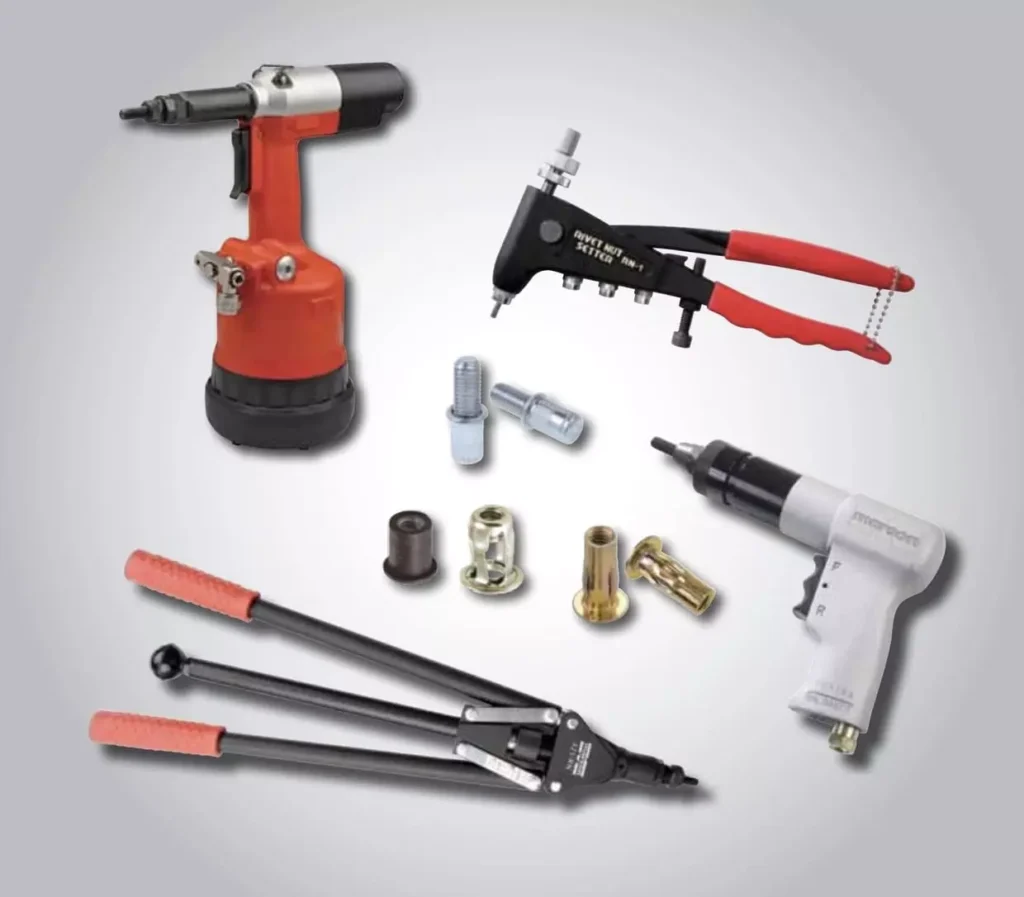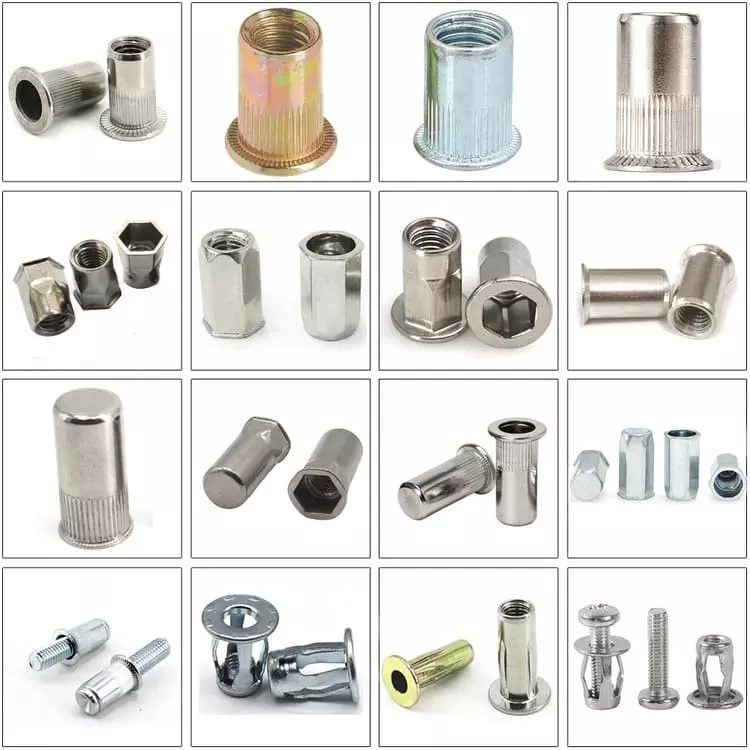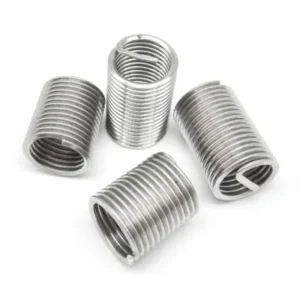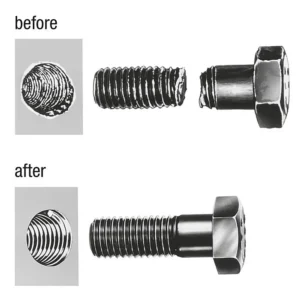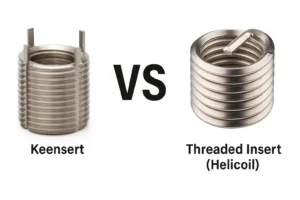Choosing the Right Rivet Nut Hole Size: An Essential Guide
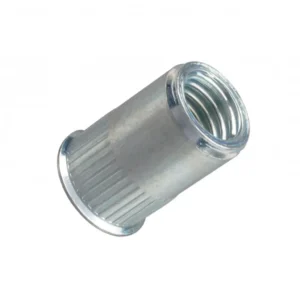
Leading Rivet Nut Manufacturer and Supplier in China
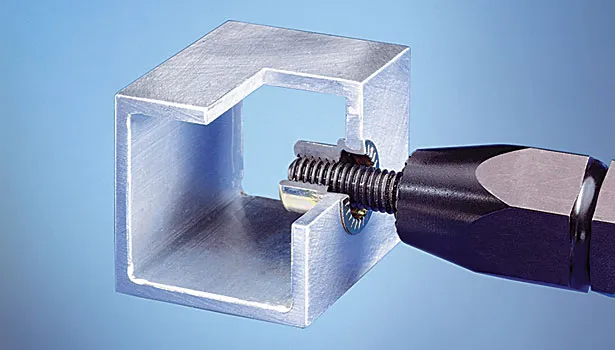
Choosing the right rivet nut hole size is crucial for ensuring a secure and reliable fastening. Whether you’re working with metal, plastic, or composite materials, selecting the correct hole diameter ensures optimal performance and longevity of the rivet nut. This guide will help you understand how to choose the perfect rivet nut hole size for your project needs.
Table of Contents
Why is Choosing the Right Rivet Nut Hole Size Important?
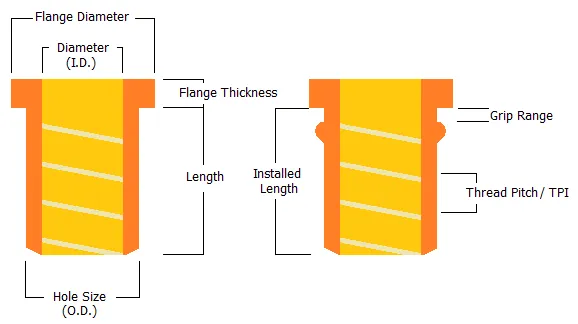
The selection of hole size plays a crucial role in the installation of rivet nuts. The right hole size not only ensures the stability of the rivet nut but also guarantees the strength and durability of the fastener.
The Impact of Hole Size on Rivet Nut Installation Stability
The design principle of a rivet nut is to apply axial tension using a riveting tool, causing the rivet nut body to expand or flare inside the hole, thus creating a secure fastening effect on the base material. Therefore, the hole size directly affects the expansion and fastening ability of the rivet nut.
- When the hole size is appropriate: The rivet nut can expand fully, tightly adhering to the base material, providing reliable gripping force, and ensuring the strength and stability of the fastener.
- When the hole size is too large: The rivet nut may not secure properly during installation, leading to loosening, rotation, or detachment, thus affecting the integrity of the connection.
- When the hole size is too small: The rivet nut may be difficult to insert and may even damage the threads of the rivet nut or the base material if forced into place, affecting its performance.
How to Ensure the Correct Hole Size
- Refer to the manufacturer’s recommended hole size data to ensure the drilled hole matches the recommended specifications.
- Use high-quality drill bits or punching tools to ensure drilling accuracy and avoid hole size errors.
- Check the hole size after drilling to ensure there are no issues with it being too large or too small. If there are discrepancies, adjustments can be made through re-drilling or adding washers.
- Choose the appropriate rivet nut type for different materials, such as using large-flange rivet nuts for soft materials (plastic, aluminum) to distribute the stress.
Factors Influencing the Selection of Rivet Nut Hole Size

Rivet nut size is the primary factor determining hole size. Each rivet nut specification has a recommended hole size to ensure proper expansion and secure fastening during installation.
- Small-Size Rivet Nuts (M3 – M6): These smaller rivet nuts require smaller holes, but due to their smaller size, hole size errors have a greater impact, and drilling accuracy is more critical.
- Medium-Size Rivet Nuts (M8 – M10): Medium-size rivet nuts require a proper hole size match to ensure stable installation. An oversized hole may lead to loosening, while an undersized hole may prevent proper installation.
- Large-Size Rivet Nuts (M12 and above): Larger rivet nuts are typically used in thick materials or high-strength fastening scenarios. The hole size needs to be highly precise to ensure the rivet nut can properly expand within the hole and provide stable gripping force.
② Material Type
The material of the base directly influences the selection of hole size, as different materials have different hardness and deformation characteristics.
- Hard materials like steel and stainless steel require high hole size precision. An oversized hole may prevent the rivet nut from securing effectively, even causing slippage.
- Softer metals like aluminum may deform during riveting, so a slightly smaller hole size can provide better gripping force.
- Due to the softness of plastics, local deformation may occur during riveting, so it is recommended to use a slightly smaller hole size to ensure the rivet nut is securely fixed.
- Specialized rivet nuts for plastic materials should be selected, such as those with larger flanges to distribute pressure.
- Composite materials are brittle, and if the hole size is too large, installation may cause the material to crack or delaminate.
- Rivet nuts with special designs, such as those with larger flanges or textured outer walls, should be used to improve grip and reduce damage risk.
- Suitable for smaller rivet nut sizes (M3-M6), with higher hole size precision requirements. Otherwise, uneven manual pulling may result in rivet nut installation failure.
- An oversized hole will reduce expansion effectiveness, resulting in an insecure fastening.
- Suitable for medium-sized rivet nuts (M6-M10), providing stable pulling force to ensure uniform expansion of the rivet nut.
- Hole size precision must be ensured to prevent the rivet nut from rotating or loosening due to uneven force.
Hydraulic Riveting Tools:
- Suitable for large rivet nuts (M10 and above), providing high pulling force, but with stricter hole size precision requirements.
- An oversized hole may prevent uniform expansion of the rivet nut, reducing fastening effectiveness, or even causing rivet nut pullout.
Do You Have Any Questions?
Let Us Solve Your Problem
Recommended Rivet Nut Hole Sizes
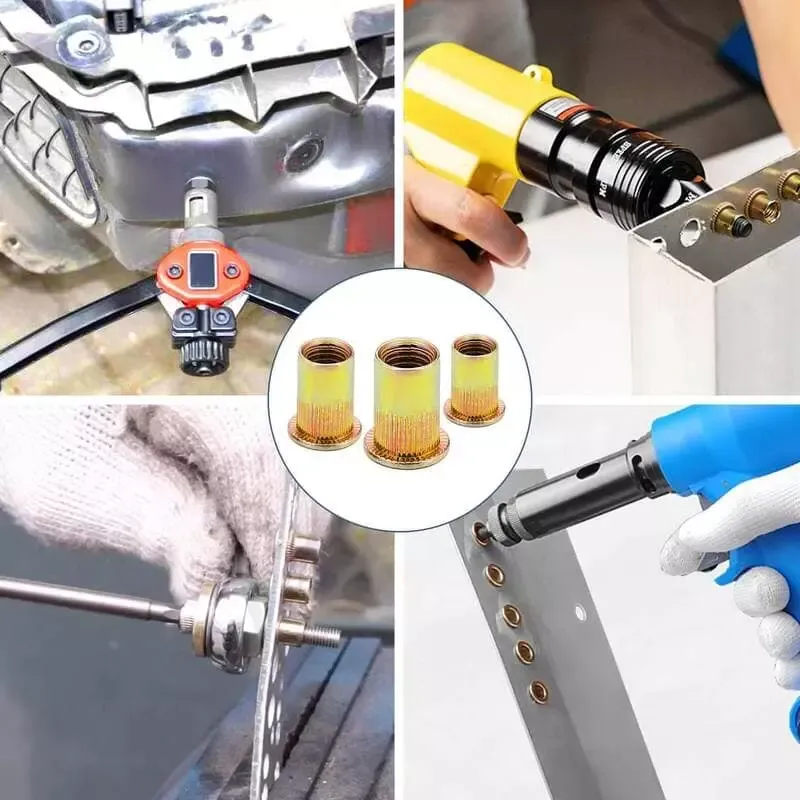
Choosing the correct drilling size is essential when installing rivet nuts. The following tables list the recommended hole sizes for common metric (M3-M12) and imperial (#6-1/2″) rivet nuts, in both millimeters (mm) and inches (in).
Form1: Metric Rivet Nut Hole Size Recommendation (Unit: mm)
| Rivet Nut Size | Recommended Hole Diameter (mm) | Applicable Material Thickness Range (mm) |
| M3 | 4.5 – 4.7 | 0.5 – 2.0 |
| M4 | 6.0 – 6.2 | 0.5 – 3.0 |
| M5 | 7.0 – 7.2 | 0.5 – 3.5 |
| M6 | 9.0 – 9.2 | 0.5 – 4.0 |
| M8 | 11.0 – 11.2 | 0.5 – 5.0 |
| M10 | 13.0 – 13.2 | 1.0 – 6.0 |
| M12 | 15.0 – 15.2 | 1.0 – 7.0 |
Form2: Imperial Rivet Nut Hole Size Recommendation (Unit: in)
| Rivet Nut Size | Recommended Hole Diameter (in) | Applicable Material Thickness Range (in) |
| #6-32 | 0.246 – 0.250 | 0.020 – 0.080 |
| #8-32 | 0.272 – 0.276 | 0.020 – 0.100 |
| #10-24 | 0.305 – 0.311 | 0.020 – 0.125 |
| 1/4″-20 | 0.375 – 0.385 | 0.020 – 0.150 |
| 5/16″-18 | 0.435 – 0.445 | 0.030 – 0.200 |
| 3/8″-16 | 0.500 – 0.515 | 0.040 – 0.250 |
| 1/2″-13 | 0.635 – 0.650 | 0.050 – 0.312 |
Important Notes
- Drilling Precision: The hole diameter should be as precise as possible to ensure the rivet nut can be securely fastened without loosening or deforming.
- Material Thickness Match: The clamping range of the rivet nut should match the material thickness to ensure effective fastening.
- Possible Variations Across Manufacturers: In practice, refer to the specific technical specifications provided by your rivet nut supplier for the best drilling sizes.
How to Properly Measure and Drill Holes?
1. Use the Right Measurement Tools
Before drilling, it is important to measure the thickness of the base material and check the outer diameter of the rivet nut to ensure proper hole size. Recommended measurement tools include:
- Vernier Caliper: Used for precise measurement of the hole diameter and rivet nut outer diameter to ensure the hole size meets the requirements.
- Thread Gauge: Used to check the rivet nut’s thread specifications and prevent incorrect installation.
- Steel Ruler or Tape Measure: Used to measure the material thickness and determine the hole location for accurate drilling.
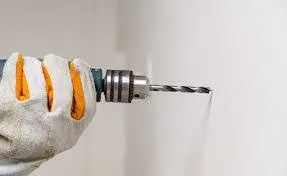
2. Choose the Appropriate Drill Bit
Different materials and hole size requirements demand the use of different types of drill bits to ensure high-quality and accurate holes.
- High-Speed Steel (HSS) Drill Bit: Suitable for general metals, plastics, and wood, with good wear resistance.
- Cobalt Drill Bit: Ideal for stainless steel and high-hardness metals, offering better heat resistance and cutting performance.
- Carbide Drill Bit: Used for composite materials or very hard materials like carbon fiber boards.
Note: The drill bit diameter should strictly follow the rivet nut’s recommended hole size table to avoid holes that are too large or too small, which can affect fastening effectiveness.
Step1. Mark the Hole Location
- Use a center punch to lightly tap the drilling point, which helps stabilize the drill bit and prevent slipping.
- Ensure the hole location is precise to avoid misalignment during rivet nut installation.
Step2. Preparation Before Drilling
- Ensure the workpiece is securely fixed to prevent movement during drilling.
- Choose the appropriate drilling speed. Recommended speeds for different materials:
- Soft metals (aluminum, copper): 1000-3000 RPM
- Hard metals (stainless steel, steel): 500-1000 RPM
- Plastics or composite materials: 1000-2000 RPM
Step3. Drilling Operation
- Apply moderate pressure and drill slowly to prevent excessive pressure, which could cause drill bit breakage or oversize holes.
- Step-by-step drilling: For thicker materials, use a smaller diameter drill bit first, then use the appropriate size drill bit to enlarge the hole, improving accuracy.
- Use coolant or cutting oil to prevent the metal from overheating and reduce drill bit wear.
Step4. Check Hole Quality
- Ensure the hole diameter matches the recommended size using a vernier caliper.
- Inspect the hole walls for smoothness. If there are burrs, use a file or deburring tool to remove them to avoid preventing the rivet nut from fitting tightly.
- Clean any debris inside the hole to avoid affecting the rivet nut’s fastening performance.
Do You Have Any Questions?
Let Us Solve Your Problem
FAQs - Choosing the Right Rivet Nut Hole Size
1. How do temperature changes affect rivet nut hole size selection?
Thermal expansion: Different materials expand and contract at different rates when exposed to temperature changes. If a rivet nut is installed in a material that expands or contracts significantly with temperature fluctuations, the hole size may need to be slightly larger to accommodate this movement. For instance, metal materials expand more than plastic, so it’s important to account for environmental factors when selecting the hole size to ensure long-term performance.
2. What if I need to install a rivet nut in a difficult-to-reach location?
Tool selection: If the installation site is hard to reach, consider using specialized installation tools, such as long-reach rivet nut tools or flexible hose tools, to ensure accurate hole placement and proper installation. The size and design of the rivet nut will also influence the installation method. Ensure the hole is drilled with precision, even in tight or awkward spaces, to avoid complications during installation.
3. Are there any considerations for hole size when using large or heavy-duty rivet nuts?
Increased load-bearing capacity: For larger or heavy-duty rivet nuts (such as those used for high-stress applications or thicker materials), the hole size needs to be particularly precise. A larger hole can allow the rivet nut to expand evenly and maintain a strong grip in thick or high-strength materials. However, an oversized hole may compromise the connection’s integrity. Therefore, it’s essential to follow the manufacturer’s recommendations for the hole size to ensure maximum load-bearing capacity and secure installation.
Rivetfix - Leading Rivet Nuts Supplier in China

As a leading fastener manufacturer in China with more than 15 years in the industry, Rivetfix are committed to providing first-class quality fasteners and responsive services to the world.
Rivetfix offers a wide range of rivet nuts designed to meet the unique demands of your projects. With options like countersunk, flat, and hex heads, as well as knurled and round body types, Rivetfix ensures you have the right solution for every application. Choose Rivetfix for versatile, cost-effective, and durable fastening solutions tailored to your specific needs. In addition, we can also provide customized rivet nuts service according to your requirements.
Contact us for project advice and the latest rivet nut quote!
Get High Quality Rivet Nuts Quote!
Send Your Rivet Nut Request
For more than 20 years, Rivetfix has helped customers solve many rivet nuts sourcing needs and technical challenges.
Have a question? Contact us and we’ll provide you with the perfect solution.

